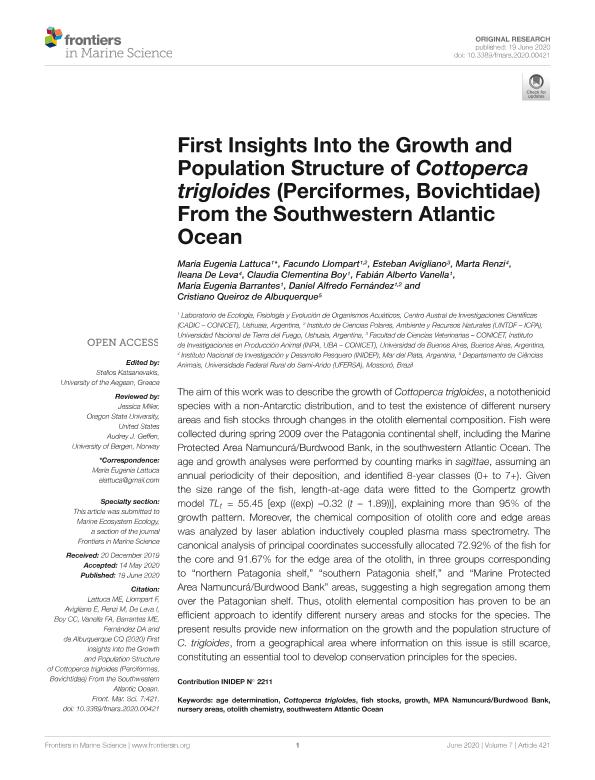Mostrar el registro sencillo del ítem
dc.contributor.author
Lattuca, María Eugenia

dc.contributor.author
Llompart, Facundo Manuel

dc.contributor.author
Avigliano, Esteban

dc.contributor.author
Renzi, Marta
dc.contributor.author
De Leva, Ileana
dc.contributor.author
Boy, Claudia Clementina

dc.contributor.author
Vanella, Fabián Alberto

dc.contributor.author
Barrantes, María Eugenia

dc.contributor.author
Fernandez, Daniel Alfredo

dc.contributor.author
Queiroz de Albuquerque, Cristiano
dc.date.available
2021-03-17T09:31:07Z
dc.date.issued
2020-06-19
dc.identifier.citation
Lattuca, María Eugenia; Llompart, Facundo Manuel; Avigliano, Esteban; Renzi, Marta; De Leva, Ileana; et al.; First Insights Into the Growth and Population Structure of Cottoperca trigloides (Perciformes, Bovichtidae) From the Southwestern Atlantic Ocean; Frontiers Media S.A.; Frontiers In Marine Science; 7; 19-6-2020; 1-14
dc.identifier.issn
2296-7745
dc.identifier.uri
http://hdl.handle.net/11336/128440
dc.description.abstract
The aim of this work was to describe the growth of Cottoperca trigloides, a notothenioid species with a non-Antarctic distribution, and to test the existence of different nursery areas and fish stocks through changes in the otolith elemental composition. Fish were collected during spring 2009 over the Patagonia continental shelf, including the Marine Protected Area Namuncurá/Burdwood Bank, in the southwestern Atlantic Ocean. The age and growth analyses were performed by counting marks in sagittae, assuming an annual periodicity of their deposition, and identified 8-year classes (0+ to 7+). Given the size range of the fish, length-at-age data were fitted to the Gompertz growth model TLt = 55.45 [exp ((exp) –0.32 (t – 1.89))], explaining more than 95% of the growth pattern. Moreover, the chemical composition of otolith core and edge areas was analyzed by laser ablation inductively coupled plasma mass spectrometry. The canonical analysis of principal coordinates successfully allocated 72.92% of the fish for the core and 91.67% for the edge area of the otolith, in three groups corresponding to “northern Patagonia shelf,” “southern Patagonia shelf,” and “Marine Protected Area Namuncurá/Burdwood Bank” areas, suggesting a high segregation among them over the Patagonian shelf. Thus, otolith elemental composition has proven to be an efficient approach to identify different nursery areas and stocks for the species. The present results provide new information on the growth and the population structure of C. trigloides, from a geographical area where information on this issue is still scarce, constituting an essential tool to develop conservation principles for the species.
dc.format
application/pdf
dc.language.iso
eng
dc.publisher
Frontiers Media S.A.

dc.rights
info:eu-repo/semantics/openAccess
dc.rights.uri
https://creativecommons.org/licenses/by-nc-sa/2.5/ar/
dc.subject
AGE DETERMINATION
dc.subject
COTTOPERCA TRIGLOIDES
dc.subject
FISH STOCKS
dc.subject
GROWTH
dc.subject
MPA NAMUNCURÁ/BURDWOOD BANK
dc.subject
NURSERY AREAS
dc.subject
OTOLITH CHEMISTRY
dc.subject
SOUTHWESTERN ATLANTIC OCEAN
dc.subject.classification
Biología Marina, Limnología

dc.subject.classification
Ciencias Biológicas

dc.subject.classification
CIENCIAS NATURALES Y EXACTAS

dc.title
First Insights Into the Growth and Population Structure of Cottoperca trigloides (Perciformes, Bovichtidae) From the Southwestern Atlantic Ocean
dc.type
info:eu-repo/semantics/article
dc.type
info:ar-repo/semantics/artículo
dc.type
info:eu-repo/semantics/publishedVersion
dc.date.updated
2021-02-17T20:56:19Z
dc.journal.volume
7
dc.journal.pagination
1-14
dc.journal.pais
Suiza

dc.journal.ciudad
Lausanne
dc.description.fil
Fil: Lattuca, María Eugenia. Consejo Nacional de Investigaciones Científicas y Técnicas. Centro Austral de Investigaciones Científicas; Argentina
dc.description.fil
Fil: Llompart, Facundo Manuel. Consejo Nacional de Investigaciones Científicas y Técnicas. Centro Austral de Investigaciones Científicas; Argentina. Universidad Nacional de Tierra del Fuego, Antártida e Islas del Atlántico Sur. Instituto de Ciencias Polares, Ambientales y Recursos Naturales; Argentina
dc.description.fil
Fil: Avigliano, Esteban. Consejo Nacional de Investigaciones Científicas y Técnicas. Oficina de Coordinación Administrativa Parque Centenario. Unidad Ejecutora de Investigaciones en Producción Animal. Universidad de Buenos Aires. Facultad de Ciencias Veterinarias. Unidad Ejecutora de Investigaciones en Producción Animal; Argentina
dc.description.fil
Fil: Renzi, Marta. Instituto Nacional de Investigaciones y Desarrollo Pesquero; Argentina
dc.description.fil
Fil: De Leva, Ileana. Instituto Nacional de Investigaciones y Desarrollo Pesquero; Argentina
dc.description.fil
Fil: Boy, Claudia Clementina. Consejo Nacional de Investigaciones Científicas y Técnicas. Centro Austral de Investigaciones Científicas; Argentina
dc.description.fil
Fil: Vanella, Fabián Alberto. Consejo Nacional de Investigaciones Científicas y Técnicas. Centro Austral de Investigaciones Científicas; Argentina
dc.description.fil
Fil: Barrantes, María Eugenia. Consejo Nacional de Investigaciones Científicas y Técnicas. Centro Austral de Investigaciones Científicas; Argentina
dc.description.fil
Fil: Fernandez, Daniel Alfredo. Consejo Nacional de Investigaciones Científicas y Técnicas. Centro Austral de Investigaciones Científicas; Argentina. Universidad Nacional de Tierra del Fuego, Antártida e Islas del Atlántico Sur. Instituto de Ciencias Polares, Ambientales y Recursos Naturales; Argentina
dc.description.fil
Fil: Queiroz de Albuquerque, Cristiano. Universidade Federal Rural Do Semi Arido.; Brasil
dc.journal.title
Frontiers In Marine Science

dc.relation.alternativeid
info:eu-repo/semantics/altIdentifier/url/https://www.frontiersin.org/article/10.3389/fmars.2020.00421/full
dc.relation.alternativeid
info:eu-repo/semantics/altIdentifier/doi/http://dx.doi.org/10.3389/fmars.2020.00421
Archivos asociados
